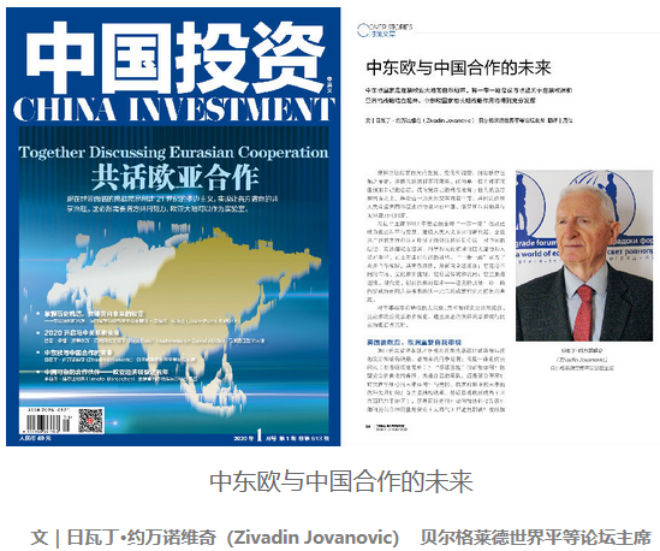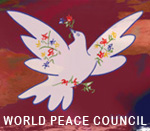Article of Mr. Zivadin Jovanovic,president of Beoforum for China investment
| Activities - China |

Central and Eastern European countries are natural ties that connect Eurasia. Combining the Belt and Road Initiative with the European Union's strategy to connect Europe and Asia will give full play to the long-term strategic role of Central and Eastern European countries
● Europe re-examines itself after Brexit
● 17 + 1 in the next ten years
● Serbian successful partner
The world is undergoing tremendous development, changes and adjustments, and the international order has also changed. The process of multipolarization cannot be stopped. No single power can impose its own will or allow its own interests to override those of others. The forces driving this historic change towards a community of equality, shared responsibility and a shared future for mankind come from China, Russia and other countries with unlimited potential.
The global “Belt and Road” initiative initiated by President Xi Jinping in 2013 has become a new model for promoting peace and development and building a humanistic future. Extensive support and recognition from around the world confirms the vision, trust in China of the initiative, the huge potential of the initiative in the economic, scientific, and cultural fields and the human aspiration for peace, justice, and a better life. The "Belt and Road" covers many areas of cooperation, is inclusive and open to the world; it connects different markets, cultures and values; it respects tradition and identity; it advocates connectivity, modernization, innovation and new technologies-these Features make the Belt and Road Initiative a unique achievement and an unprecedented model for the future of mankind.
For those with privilege, it is time to think about how to adapt to the multipolarity of the world's economic, financial, and political relationships, build true partnerships, and practise democratic governance.
After Brexit, Europe re-examines itself The confusion sparked by the British dispute over the terms of the European Union has exposed the EU's deep political and structural flaws. The outstanding debates are: Where does EU integration go (should it be more focused)? What are the prospects for a "multi-speed EU"? EU security will be guaranteed by NATO, or its own army, or joint security? What is the future of the transatlantic axis? What are the future partnerships with the United States, Russia and China? First, structural reforms, then new members (from the Western Balkans), or at the same time? How to speed up technological development? How to provide reasonable energy security (natural gas) and avoid sanctions? Should EU funds continue to be secured through contributions from member countries, or should independent direct income (taxes), budgets, banks be used? As for Britain, it will take at least another year or so for hard negotiations to sign a free trade agreement. At the same time, will the "Five Eyes Alliance" (USA, Canada, UK, Australia, and New Zealand) form a comprehensive common strategy similar to the "Group of Five"?
European Green New Deal. The first policy launched by the newly established European Commission is the European Green New Deal, which aims to reduce carbon dioxide emissions by 50% by 2030 and make Europe the first climate-neutral continent by 2050. Emissions will be reduced to levels that can be naturally absorbed and processed. The new European Commission President Ms. Ursula Vondelion announced the policy in her address to the European Parliament. The Green New Deal is not a portfolio or sector, but a "necessary move" for the entire EU economy. "Industrial strategies enable us to develop new technologies while creating new markets." As can be seen, the plan is a comprehensive restructuring of the EU economy. Obviously, the ambition is even greater. Von Delaney stressed in his speech that "the world needs the EU to play a leading role in protecting the environment."
17 + 1 in the next decade
The Belt and Road cooperation with Central and Eastern European countries is the general trend, because the Belt and Road Initiative is a multi-dimensional global cooperation, and the Central and Eastern European countries are natural ties connecting Eurasia. With the passage of time, the role of China-Central and Eastern European countries in connection with China will renew its vitality and play an increasingly important role. By combining the Belt and Road Initiative with the European Union's strategy to connect Europe and Asia, the long-term strategic role of Central and Eastern European countries will be fully leveraged. The cooperation mechanism between the countries of Central and Eastern Europe and China is of strategic significance. In terms of quantity and quality, especially its irreplaceable role of interconnection, it is an important part of the overall cooperation between China and Europe. On the other hand, this cooperation mechanism plays an important role in improving the level of socio-economic and technological development, as well as the economic modernization of Central and Eastern European countries, and helps alleviate development and social differences between EU regions.
It should be noted that about 25 million people in Central and Eastern European countries (the so-called "new Europe") have moved to the western part of the European Union in search of better employment and a higher standard of living. This kind of "internal migration" or "brain drain" has caused young people in Central and Eastern Europe to lose their higher education training and directly affected development goals. For example, official EU statistics (Eurostat) show that 17.3% of the EU's total population (about 500 million), and about 87 million people are below the poverty line. The vast majority live in or come from Central and Eastern European countries. Creating new employment opportunities and helping to improve living conditions through cooperation between Central and Eastern European countries and China will undoubtedly play a positive role in solving these serious problems.
The great achievements achieved through the 17 + 1 cooperation mechanism are based on important consensus. First, the foundation of this cooperation is to fully respect the win-win principle of sovereignty, equality, non-interference and mutual benefit; second, cooperation always conforms to national and international laws, regulations and standards (WTO); third, cooperation values openness , Connectivity and coordination; fourth, the 17 + 1 mechanism is a natural supplement and necessary component of China-EU relations and China-EU strategic comprehensive partnership; fifth, economic cooperation and cultural exchanges between the two sides are two equals of peace, stability and prosperity important part.
Ten years ago, Central and Eastern European countries focused on addressing the global financial and economic crisis (2008-2012) and minimizing its impact. At present and in the next ten years, these countries are working hard to upgrade and upgrade their infrastructures to modernize, strengthen their economies, adopt new technologies, improve living standards, reduce differences, create employment opportunities, reduce brain drain to normal levels and eradicate poverty. There is no doubt that these goals are important, legitimate, and consistent with the goals of the 17 + 1 cooperation mechanism.
There is no doubt that the fruitful cooperation in the past has laid a solid foundation for achieving the greater goal of 17 + 1 cooperation in the next ten years. This is not only the best solution that can best meet the expectations of the national economy and people for a better life, but also will make an important contribution to China-EU cooperation and the overall promotion of the Belt and Road Initiative. The more uncertainties and clouds of economic, financial and social fields that Europe and the world face, the more it is necessary to maintain and strengthen positive measures such as 1 + 17 cooperation.
Infrastructure modernization will remain a top priority for Central and Eastern European countries in the next decade. Specifically, the Three River Corridor covering high-speed railways and highways (upward of the Vardar River, connecting the Morava River, and finally the Danube River) needs to be finalized and extended, also known as the Pan-European Corridor 10, in order to make full use of The Central European Land and Sea Express is fully functional and connects the Greek port of Piraeus with Central Europe and the Baltic Sea. The Belgrade-Budapest high-speed railway is already under construction. The first expansion should connect Nice-Skopje (Northern Macedonia) -Thessaloniki-Piraeus (Greece) south of Belgrade. At the most recent 16 + 1 summit in Dubrovnik (April 2019), participants noted the initiative to extend the Belgrade-Budapest high-speed railway to the Black Sea, Adriatic Sea and the Baltic Sea. The implementation of the project will involve the participation of almost all Central and Eastern European countries, China, and some other EU member states. With this in mind, coupled with the Aegean Port (Greece), it may be time to rename the current Sanhai Port Cooperation Organization to the Four Seas Port Cooperation Organization. What's more, Greece has been officially accepted as a participant during the Dubrovnik China-CEE leaders' meeting this year, transforming this cooperation mechanism to 17 + 1.
Investment cooperation will continue to be a priority, especially in the industrial and energy sectors. In this regard, it is important to pay attention to the strict requirements of the European Union regarding green technology and public procurement procedures. From now on, every new cooperation agreement must include provisions that meet the requirements of green development.
It is widely believed that Europe lags behind China and the United States in developing new technologies, especially artificial intelligence. Realizing this, the European Union began to pay special attention and allocated a large amount of funds to narrow the gap in this regard. The problems are particularly acute in those countries with underdeveloped economies, especially those that remain unstable (Serbia, Montenegro, Bosnia and Herzegovina, Albania and Northern Macedonia).
Modernization in the fields of railways, highways, ports, power plants, bridges, logistics, "green" transformation, digital and artificial intelligence technologies are top priorities in Central and Eastern European countries. And China has undoubtedly made remarkable achievements in these areas and has become a partner that can help.
Successful partners in Serbia Since the establishment of the 17 + 1 cooperation platform, Serbia has been an active and successful participant. This success stems from a long tradition of friendly relations between Serbia and China, which is based on bilateral and multilateral cooperation of mutual trust, mutual respect and mutual benefit. The two countries share common goals in international relations, such as: peace, respect for international law and the Charter of the United Nations; and a world order based on the principles of sovereign equality, territorial integrity and non-interference in internal affairs. The two countries support each other on the international stage. Serbia adheres to the "One China" principle, and China also supports the "One Serbia" principle. Kosovo and Metohija are considered as an integral part of Serbian territory. China is the world's second largest economy and a permanent member of the UN Security Council. For Serbia, it is vital to become a trusted friend and a true comprehensive partner of China. With the continuous development of modern economy, science and technology, China has become the source of power for global economic growth in the 21st century.
No other country in the world, like China, has invested so much creativity and resources in new development plans, institutions and organizations that benefit human well-being. China, together with other peace-loving countries, plays a key role in establishing a new, multipolar, open, fair and inclusive world order without domination or hegemony. To achieve these goals, China has all the capabilities, including the strongest and most reliable diplomacy.
Chinese companies have been actively involved in the construction of several railway and highway international corridors, including: 1.
The Belgrade-Budapest high-speed railway under construction, with a total length of 335 kilometers and a cost of about 2.58 billion euros (Serbia), is loaned from China and Russia. The Belgrade-Novi Sad section will be constructed by China Railway International Co., Ltd., China Communications Construction Group Co., Ltd. and Russian companies. The 2019 Dubrovnik Central and Eastern European Countries Summit will extend the railway to three seas-the Adriatic Sea, the Black Sea and the Baltic Sea. Serbia's southern branch of Pan-European Corridor 10 (Belgrade-Nice-Skopje (Northern Macedonia), Thessaloniki and Piraeus (Greece) and the eastern branch of Sofia (Bulgaria)-Istanbul (Turkey) The construction of modernization is highly concerned. The construction of this line is a prerequisite for the efficient and full-load operation of the China-Europe Land and Sea Express Line, which will greatly reduceThe corridor from Belgrade to the South Adriatic Highway 11 is 483 kilometers long and costs about 3 billion U.S. dollars. China Communications Construction Group Co., Ltd. plans to expand to Timisoara, the Black Sea and the Trans-Adriatic, Region to Bari, Italy; 3.
In the final construction phase of the Belgrade cross-border highway ring network, a total length of 69 kilometers, including 8 bridges, 2 kilometers of Ostruznica Bridge, across the Sava River, and 6 tunnels, was undertaken by China Communications Construction Group Co., Ltd. the time and cost of cargo transportation between Europe and China;
2. The future can be expected. Don't guess, speak with reliable experience, trust each other, and evaluate rationally. First, it is necessary to continue and successfully complete the construction of strategic projects in infrastructure, industry and other fields. The urgent task is to complete the modernization of railways and highways on the entire Pan-European corridor 10, so as to complete the China-Europe Land and Sea Express. Related to this:
(1) Prepare for the extension of the project to three sea areas, namely the Adriatic Sea, the Black Sea and the Baltic Sea. If possible, we can consider China Unicom's fourth sea-including the Aegean Sea and Thessaloniki.
(2) Further focus on cooperation between the Four Seas and inland water ports. Serbia intends to include the Danube port in the scope of cooperation, as well as the modernization of this first inland roadway in Europe.
On the Danube, the Mihajlo Bridge
The establishment of an industrial, technological and scientific park near Pupin) will be the first construction of this type and scale in Europe, and Serbia's priority project in the 17 + 1 cooperation mechanism and bilateral cooperation. Preparations have been completed and construction is expected to begin early this year. The park focuses on science and new technologies and will serve as a model window. It will provide higher education, specialized training and employment opportunities for about 15,000 young people from Serbia and other regions. There, digital, green solutions will find the right way to meet demand. A similar industrial park is planned in the steel city of Smederevo on the Danube.
Many other initiatives and projects are being planned. One is the establishment of three hydropower plants (North Biella, Foca, and Panch) on the Drina river on the border between Serbia and Bosnia and Herzegovina (Republika Srpska). Other projects include water purification plants, food production and processing projects, and irrigation plans.
Humanistic exchanges have inspired tremendous power. Scientific and cultural education institutions, associations and think tanks have made great contributions to enhancing understanding, mutual respect and trust. Tourism is booming. Serbia and China cancelled tourist visas and strengthened the promotion of tourist information, making tourism the fastest-growing area of cooperation. However, regional approaches to organization and development planning may create new possibilities.
With rich experience, huge cooperation possibilities and strong belief that the 17 + 1 cooperation mechanism is the right way to build a better future, we will continue to get more and greater results in the next ten years.
Edit | Zhang Mei
Source: https://www.chinainvestment.com.cn/type_fmgs_post/40337.html
| < Prev | Next > |
|---|
| Overstatement from Davos 2017. |
Liberal corporative capitalism, for reasons of lowering traveling costs, proposed not to travel to history alone but packed togather with NATO, EU and unipollar World Order. Workers participation has good chances to step in provisionally, buying time for full scale workers selfmanagment. |









